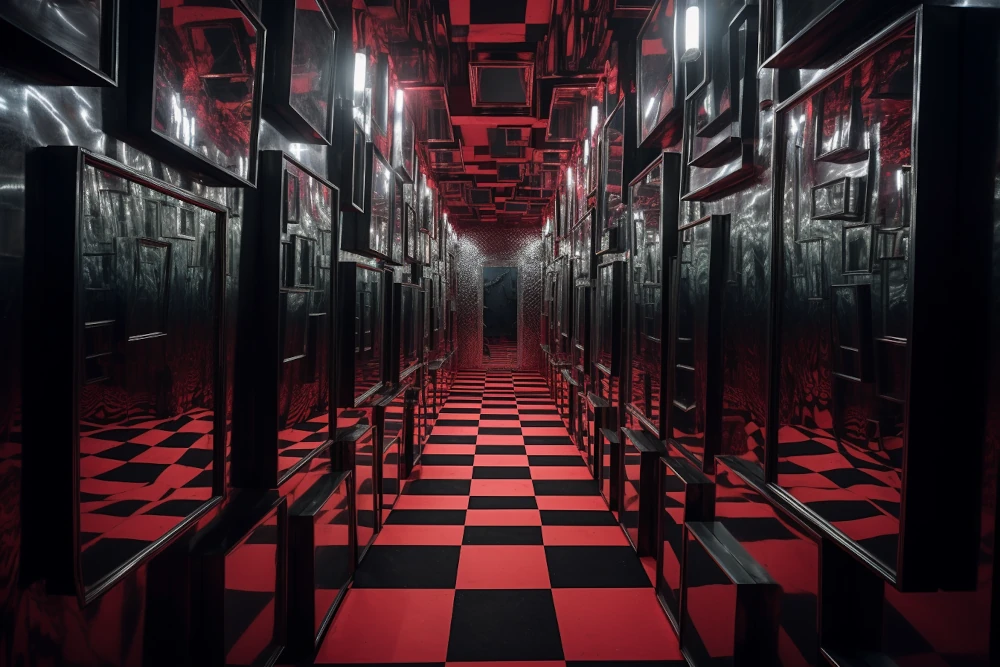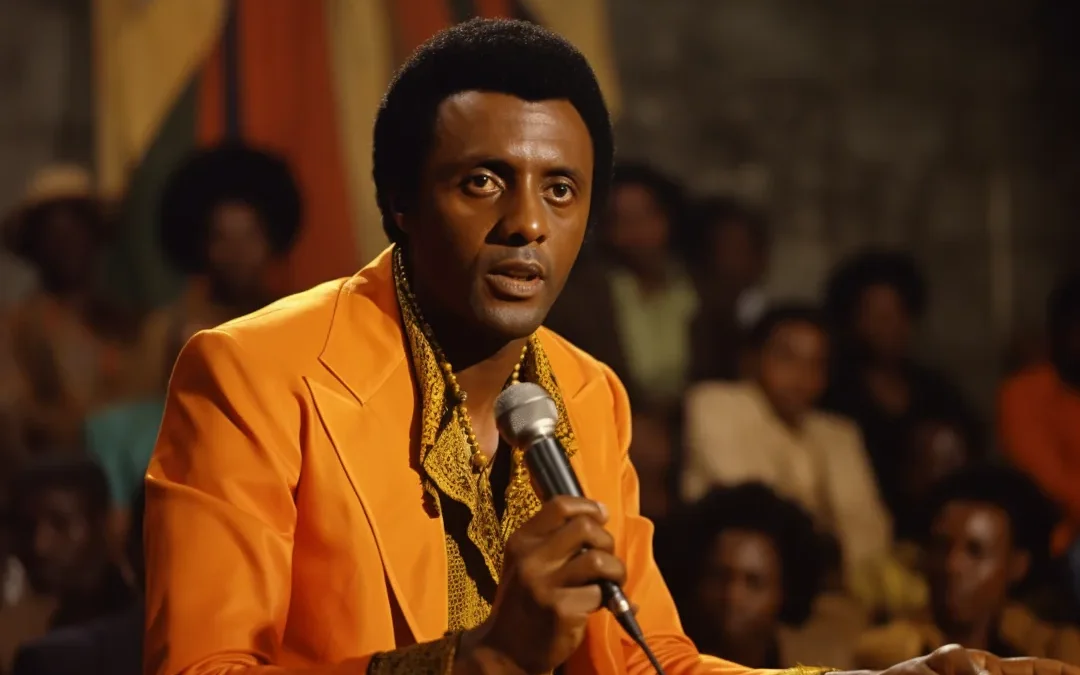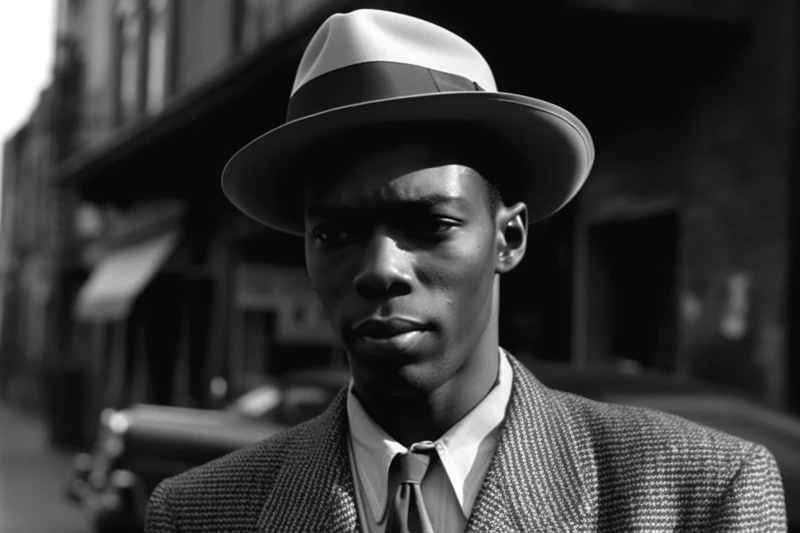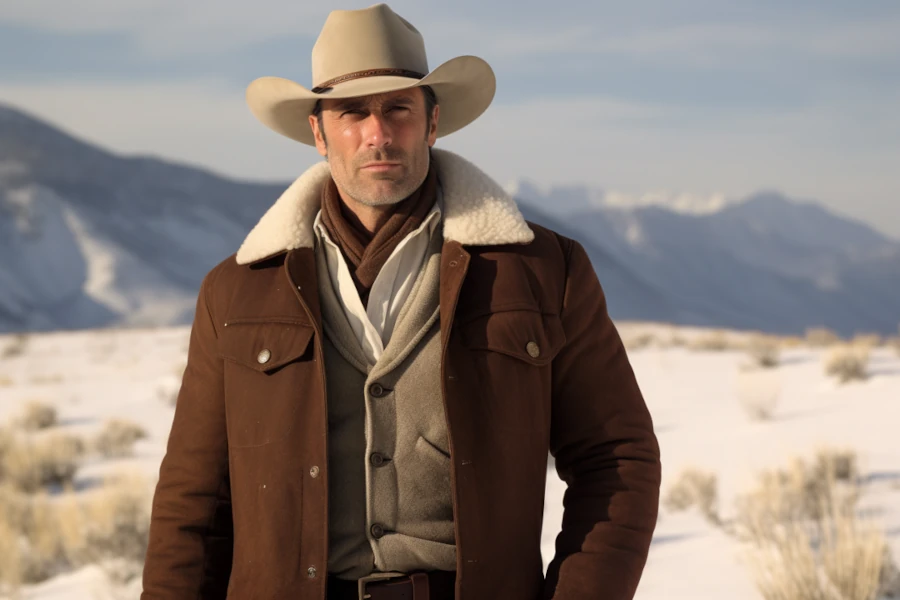- Fargo Season 1
- Fargo Season 2
- Fargo Season 3
- Fargo Season 4
- Fargo Season 5
If it turns out that Fargo creator Noah Hawley is actually an artificial intelligence, I wouldn’t be surprised in the least. AI generated images have an eeriness about them because at first glance they appear to be great art or perfect photographs, but once you pay attention to the details you notice something amiss. Just look at the photo above! The same goes for AI generated text. It has the right flow and tone but sometimes this comes at the expense of making sense or factual accuracy.
Fargo, season one, features tall apartment buildings in a North Dakota city that contains no tall apartment buildings. In Fargo, season 5, skyscrapers loom in the background of a shady strip club in a county that doesn’t even have a tall building, let alone a skyscraper. We’re also led to believe that the villains travel from this county on the west side of North Dakota to a place outside the Twin Cities as if it were the next county over (sometimes it takes longer, it just depends what the plot requires).
If anything has defined Fargo, it has been Hawley’s general disregard for reality. While it might not occur to many audience members that the rural backwoods of North Dakota is, in fact, a rural backwoods, at times this sloppiness can be jarringly stupid. For example, at one point a character gets in a hospital elevator to go to the third floor. We cut to another character in the parking lot, about to enter the one story hospital building. I could continue and repeat my gimmick from Fargo, season three, where I just listed plot holes, but I’ll restrain myself.
Yet for some reason Hawley always does all the television stuff just right. The pace of the plot keeps you engaged, the opening shots perfectly lead you into a scene, the characters are framed just right. The only explanation that really makes sense to me is that Hawley knows television better than he knows real life. He produces simulacra—copies of copies—because his art has no basis in reality. It just copies all the television shows and movies he’s seen throughout his life. Movies like Fargo. But the Coen brothers grounded Fargo in realities so much so that people actually believed the bit about being a true story. The simulacrum, on the other hand, has been molded out of plastic.
Season 5: A decent plot poorly executed
Season 5 of Fargo has an interesting premise undermined by poor execution. We follow Dorothy Lyon (Juno Temple), a seemingly normal mother who spends a few hours in jail after accidentally tasing a police officer in the melee of a school board meeting gone wrong. Her finger prints go through the system, bringing her to the attention of Sheriff Roy Tillman (Jon Hamm), her kooky and abusive ex-husband who has been searching for her for ten years.
Sheriff Tillman is some sort of weird love child between Sheriff Joe Arpaio and David Koresh. Conceptually, that’s awesome, and Jon Hamm looks the part. Unfortunately, he does not sound the part and the writers clearly have no ability to get inside the mind of such a character. He appears to be a liberal caricature of the rural God fearing, Trump loving, libertarian authority figure.
Tillman insists on being so absurdly outrageous in all things that from the start no audience member would fear he might succeed. He begins by telling two FBI agents that he doesn’t respect federal law and challenges them to stop him. The only reason he’s not hauled off to jail for stealing munitions from the county government and passing them off to a militia is because this is Fargo and that would be inconvenient to the plot. The tit-for-tat between Tillman and the FBI agents is particularly annoying considering that none of these law enforcement officers seem to understand American laws because the writers couldn’t be bothered to do a modicum of research. These two are slightly more competent than Key and Peele from season one, but not by much.
Dorothy also must contend with her suspicious mother-in-law, Lorraine Lyon (Jennifer Jason Leigh), a billionaire whose wealth places her above the law in absurdly unrealistic ways. Instead of asking this powerful woman for help, Dorothy instead refuses to admit a problem exists, even while she booby traps her house. Her naive husband believes any ridiculous lie she comes up with. He’s not just Minnesota nice, his kindness instead manifests from a absurd ignorance that belies his upbringing and experiences.
In addition to our ignorant FBI agents, two police officers attempt to investigate the events surrounding Dorothy. Indira Olmstead (Richa Moorjani) initially arrests Dorothy while Witt Farr (Lamorne Morris) unwittingly comes to her rescue with a routine traffic stop. However, unlike seasons 1–3, the investigation by the officers does not take precedence. The plot primarily revolves around Dorothy, her mother-in-law, and Sheriff Tillman’s clan and hired guns.
The clumsy attempt at foreshadowing in episode one gives away any mystery. It quickly becomes clear the direction the plot will take not only in the episode, but for the entire season. Because the bad guys appear so incompetent and the good guys are all “survivors,” the show never surprises.
Characters hit or miss
The characters in Fargo, season 5, do not appear to all be of the same world. There’s an incongruity to them that doesn’t make sense, as if the show runners allowed the actors to implement their own interpretations rather than direct a coherent vision. Accordingly, some performances are stellar while others are terrible.
Juno Temple does a fantastic job with the lead role, exuding the necessary quirkiness and emotional range to really sell the character. The cops played by Lamorne Morris and Richa Moorjani also have competent performances, although their personalities largely use the template originally set by Frances McDormand in the original film and used in seasons 1–3. Fargo continues to impress with casting, especially when finding unique roles for comedic actors. Dave Foley knocks it out of the park as Danish Graves, Lorraine’s shady lawyer.
We also have an interesting hired gun, Ole Munch, who has a weird supernatural element to him. Munch pays homage to Peter Stormare in the original Fargo film, but even more so he appears to draw inspiration from Cormac McCarthy’s otherwordly antagonists (Anton Chigurh, Judge Holden, etc.). The man personifies the grand metaphor of the season, but it seems rather forced. As an idea, Munch may be the greatest strength of the season, but his reason for participating in the plot can never be reasonably answered.
Other characters have an extremely rough go of it. This tends to correlate with lots of dialogue, because the dialogue is terrible. Jennifer Jason Leigh puts in a particularly cringe-worthy performance as Lorraine. The script does her no favors as she babbles on like a comic book villain about her disdain for the poor. Her accent is baffling and impossible to place—some cross between Boston Brahmin and a gangster from a 1930s crime movie.
Joe Keery plays Sheriff Tillman’s son and deputy, Gator, and while Keery does an admirable job with the lines he’s given, those lines are terrible. Gator plays the alt-right stereotype, fueled by malice and obsessed with displays of strength. There are attempts at times to provide Gator with a depth the elder Tillman lacks, but this fails because Gator is not the sort of undisciplined son his father would raise. This is what I mean by an incongruity among the characters.
Throughout all five seasons of Fargo, the writers consistently demonstrate a general ignorance of people. How can a writer craft believable character when they just don’t get people? It also stems from the simulacra problem. When characters are inspired by other fictional characters rather than real people, we end up with hollow caricatures with nonsensical actions, backstories, and motivations.
The Grand Metaphor of Fargo, season 5
Season 3 of Fargo took an interesting turn by employing a grand metaphor, albeit a trite one fumbled without any elegance or subtly. That season attacked wealth and man’s desire to obtain more than he could ever make use of. The antagonist personified this by gorging and then purging.
Where season 3 personified wealth through mastication, season 5 personifies debt. I won’t spoil the details, but the entire season hinges on this rather strained metaphor. Lorraine reinforces this idea, with her billions of dollars from purchasing debt at a discount and collecting. To make things complimentary, officer Olmstead struggles with debt incurred by her unemployed husband’s reckless spending. Played by Lukas Gage, Olmstead’s husband might be the most irritatingly one dimensional and unbelievable character in the entire series. Sheriff Tillman believes Dorothy to be permanently indebted to him for their marriage vows, which she gave under duress as a child.
As a high-level concept, the theme has the strength to really make the season special. The execution falls far short because the show runners don’t know how to explore the theme with any subtly. Instead we get cringe-worthy exposition, such as Lorraine over-explaining her disdain for the poor or Sheriff Tillman preaching his self-serving perversion of Christianity. In situations like these it feels like the writers have no faith in the audience to understand a metaphor without having it spelled out. But what’s really going on is the opposite. The writers lack the talent to construct an elegant metaphor.
More of the Same Fargo
The strengths and weaknesses of previous seasons once again crop up in season 5 of Fargo. It looks and feels like a masterpiece but only if you shut your brain off. Start listening to the dialogue the artifice becomes distracting. Pay attention to the great opening shots and the sets reveal themselves. Consider the logic of the plot and it collapses like a house of cards. Like an AI image, it’s fine until you look closely and realize the figures have extra fingers and are set against a mysteriously nonsensical backdrop. Fargo cannot maintain the suspension of disbelief because it wants to be all things. Gritty and real. Supernatural and spooky. Detailed and serious. Funny and irreverent. These are the types of odd combinations that the Coen brothers excel at, but they do so by deciding specifically what a film will be from the outset. The television series does not know what it wants to be and its identity can wildly oscillate from one scene to the next, one episode to the next.
My working theory is that everyone involved in Fargo comes from an upper middle class family. The show demonstrates no understanding of the poor and working classes, but also shows a disdain for the rich and portrays them all as Bond villains. Most frustratingly, the show runners appear to have no understanding of the Midwest. Everything they know about this place and these people comes from Joel and Ethan Coen’s Fargo, a film so wonderful because its creators intimately understood the setting and characters they imagined.
There’s the old cliché of “write what you know” and all too often authors take this advice too literally with memoir-like stories. The Coen brothers demonstrate that writing what you know doesn’t mean telling your life story, it means crafting characters and plots that pass the sniff test. They maintain the suspension of disbelief throughout, whether we inhabit a hard realism or a world of magic. You achieve this by understanding people. Their quirks, motivations, and self-deceptions. The Fargo television series is the exact opposite of this.
Fargo, the series, has been trained using the data from great artists but that’s just not enough. You cannot infuse a soul into the soulless. When artificial intelligences begin to make complete television shows, they will remind us of Fargo.









